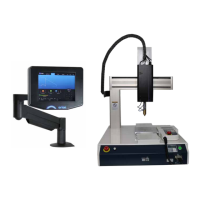51
•Check the Tip Retract Delay in the “Ignition menu.” Decrease this time a little to increase successful welds.
Q. WHAT IS THE THICKEST SHEETING THAT CAN BE WELDED?
•Weldable sheet thickness varies depending on the type of material.
•Highly conductive materials like copper can generally be welded up to 0.020” thick.
•More resistive metals may be slightly thicker than the conductive metals.
•e relative size of the two components being welded should be comparatively similar.
•in conductive sheets welded onto thick conductive bases will be less successful (the bottom portion
acts as a heat sink and wicks energy away from the weld site) than thin sheet to thin sheet.
•If the top layer is too thick, the weld will not fully penetrate to the bottom sheet.
•Sometimes it can be useful to experiment with which material acts as the top layer when the application
permits.
•COPPER to ALUMINUM – since the melting temperature of aluminum is lower than that of copper, it is
best to use the copper as the top layer to avoid blowing holes in the aluminum.
•If the top layer is NICKEL or NICKEL COATED, the nickel can stick to the electrode and cause erratic weld
behavior over time. Ideally, the NICKEL would be used as the lower layer.
•COPPER to STEEL - it is generally best to have the copper layer on top since it will absorb the majority of
the energy.
•Some metals combine to form an alloy that is not as strong as the original metals. In this case it can be
useful to insert a third metal between the two layers to act as a binder. Nickel tabs work well in several
circumstances.
•With experimentation, one can determine how many layers can be welded at one time.

